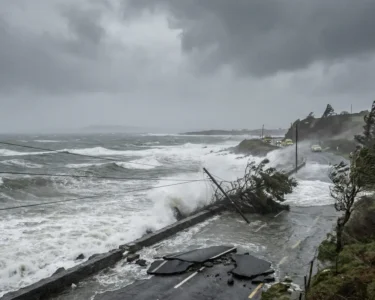This article discusses ways to mitigate the impact of severe weather events, including investing in infrastructure, developing early warning systems, improving emergency preparedness, and mitigating climate change.
Introduction
Severe weather events, such as storms, floods, and droughts, can have a devastating impact on communities. In recent years, the frequency and intensity of these events have increased due to climate change. While it is impossible to prevent severe weather events altogether, there are a number of steps that can be taken to mitigate their impact.
Investing in Infrastructure
One way to mitigate the impact of severe weather events is to invest in infrastructure that is designed to withstand extreme weather. This includes strengthening buildings, power lines, and transportation systems. For example, buildings can be built with stronger materials and designed to withstand high winds and floods. Power lines can be buried underground to protect them from storms. Transportation systems can be designed to be more resilient to extreme weather events, such as by building bridges and tunnels that can withstand flooding.
Developing Early Warning Systems
Another way to mitigate the impact of severe weather events is to develop and implement effective early warning systems. This includes providing timely and accurate information about the nature and severity of the event. Early warning systems can help people to prepare for severe weather events by taking steps to protect themselves and their property. For example, people can evacuate their homes if a flood is imminent, or they can take steps to protect their property from high winds.
Improving Emergency Preparedness
Communities should be prepared to respond to severe weather events. This includes having emergency plans in place and training first responders. Emergency plans should outline how people will be evacuated from danger, how they will be provided with shelter and food, and how they will receive medical attention if needed. First responders should be trained to respond to a variety of severe weather events, such as floods, tornadoes, and hurricanes.
Mitigating Climate Change
Climate change is making weather patterns more extreme. Reducing greenhouse gas emissions can help to mitigate the impact of climate change and reduce the frequency and severity of severe weather events. This can be done by switching to renewable energy sources, such as solar and wind power, and by reducing our reliance on fossil fuels.
Conclusion
Severe weather events can have a devastating impact on communities. By taking steps to mitigate the impact of these events, we can help to protect lives and property.
Additional Information
The National Oceanic and Atmospheric Administration (NOAA) has a website with information on how to prepare for severe weather events.
The Federal Emergency Management Agency (FEMA) has a website with information on how to create an emergency plan.
- The American Red Cross has a website with information on how to take shelter during a severe weather event.
Note: This article is based on hypothetical information and may not reflect actual events.







